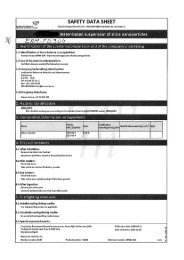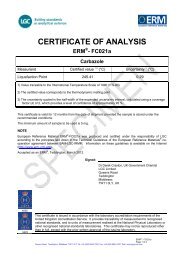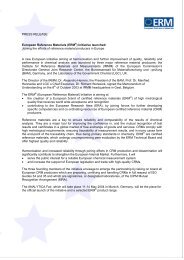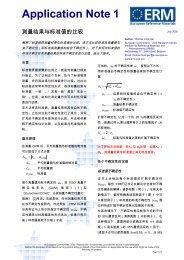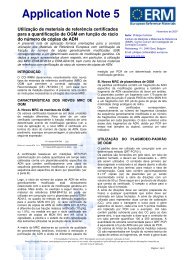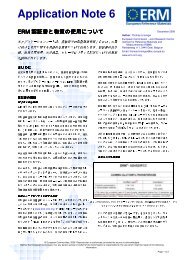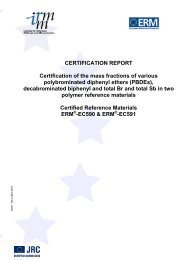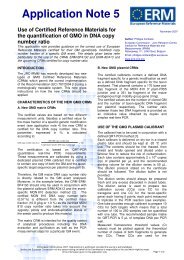Certification Report Certified Reference Material ERM - European ...
Certification Report Certified Reference Material ERM - European ...
Certification Report Certified Reference Material ERM - European ...
You also want an ePaper? Increase the reach of your titles
YUMPU automatically turns print PDFs into web optimized ePapers that Google loves.
− SAXONIA Edelmetallrecycling GmbH, Halsbrücke (Germany)<br />
− Umicore AG & Co. KG, Hanau (Germany)<br />
− Umicore Precious Metals, Hoboken (Belgium)<br />
− Varian, Darmstadt (Germany)<br />
− W.C. Heraeus GmbH, Hanau (Germany)<br />
− Wieland Edelmetalle GmbH & Co, Pforzheim (Germany)<br />
− WRC World Resources Company GmbH, Wurzen (Germany)<br />
Statistical evaluation of the data<br />
− BAM Bundesanstalt für <strong>Material</strong>forschung und -prüfung, Berlin<br />
3. Candidate material<br />
Approx. 40 kg of used mixed printed circuit boards were taken as initial material. These<br />
boards were doped with Be, In and Pt, ashed and melted with approx. 40 kg of pyrite (FeS2).<br />
After milling and grinding the material was sieved to a particle size below 150 µm and<br />
homogenised thoroughly. The material was then bottled in 200 ml amber glass containers<br />
each filled with 200 g of material. The bottles were sealed with screw caps equipped with PE<br />
insert and with shrinking foil. In total 250 bottles were filled.<br />
4. Homogeneity testing<br />
Three laboratories performed analyses for homogeneity testing. Each laboratory received<br />
five randomly chose bottles (Table 1). The laboratories were asked to analyse all elements<br />
once in four bottles and four times in the fifth bottle. Lab. 3 carried out additional analyses on<br />
all five bottles (3 to 6 single results depending on the element).<br />
Table 1: Homogeneity testing, chosen bottles (in brackets: number of single results)<br />
Laboratory-No. 1 2 3<br />
Bottle-No. 3 (4) 10 (1) 122 (3-6)<br />
54 (1) 28 (1) 143 (3-6)<br />
111 (1) 48 (1) 159 (3-6)<br />
202 (1) 118 (4) 179 (3-6)<br />
222 (1) 147 (1) 241 (3-6)<br />
From the data of each laboratory an estimator for the inhomogeneity contribution was<br />
calculated according to Eqs. 1 - 6.<br />
MS<br />
bw,<br />
i<br />
=<br />
ni<br />
∑<br />
k = 1<br />
dev<br />
i<br />
k , i<br />
n −1<br />
ni = number of bottles tested in the ith laboratory (k = 1… ni)<br />
( ) 2<br />
M M<br />
dev = p ⋅ −<br />
(2)<br />
k,<br />
i k,<br />
i bottle _ k total , i<br />
7<br />
(1)



